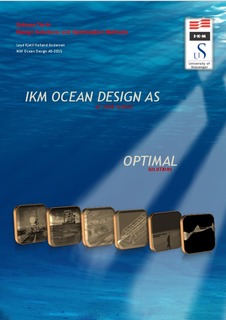| dc.contributor.author | Andersen, Loyd Kjetil H. | |
| dc.date.accessioned | 2015-09-14T08:13:05Z | |
| dc.date.available | 2015-09-14T08:13:05Z | |
| dc.date.issued | 2015-06-15 | |
| dc.identifier.uri | http://hdl.handle.net/11250/299670 | |
| dc.description | Master's thesis in Mechanical engineering | nb_NO |
| dc.description.abstract | Subsea Tie-in Systems is used to connect pipes between subsea structures in the offshore oil and gas industry. Subsea Tie-in system has been developed for many decades by the industry, and is used throughout the world in many subsea oil and gas fields of today. Industry experience and various piping codes have been developed and used in the design over the years. However there has been a lack of recommended standard practice and guideline for designing such systems. In this thesis two computer software analysis packages commonly used in the industry for structural analysis of piping systems is explored and compared. A vertical spool design case is investigated by the use of finite element analysis. Relevant design load cases are identified and a design basis is established for the analysis. Relevant piping codes such as ASME and DNV are used in the design. Some of the main challenges which have a great influence on rigid spool design are the fabrication tolerances and metrology, which has to be accounted for in the design. This thesis gives proposal on how to implement statistical distribution of tolerances in the analysis by use of design exploration tools included in the ANSYS Software package. Advantages and disadvantages are described.
The thesis will present some theory and examples to gain a general understanding about the content to be presented. An Introduction of the most common Tie-in Systems and their basic configurations and shape is presented. Advantages and limitations are described. Recommendations and suggestions for future spool design solutions and load mitigations are given.
In this thesis a vertical spool has been analysed with a statistical and probabilistic approach for the metrology and tolerances, the results shows that it is beneficial to include such method in order to better document the safety level and the conservatism in the spool design. The approach also allows the engineer to make a better decision towards the optimisation process of the spool.
The thesis also shows that simple mitigation measures for a vertical spool such as pre-bending and introduction of a seabed support and buoyancy onto the spool has positive effects by reducing the resulting bending moments at connector ends, and can reduce the total stresses in the spool. The results also show that the vertical spool design is is very sensitive to VIV and hence fatigue capacity governs the design.
The vertical spool design has also been checked by use of the commercial piping software package AutoPIPE from Bentley. The results compared to the ANSYS analysis shows that there is a minimal difference in utilisations when using pipe beam element technology. The software is found to be feasible for usage in subsea spool design for small to moderate displacements and deformations, however for an optimised weight design it is recommended to perform a FEA with solid element models in ANSYS. | nb_NO |
| dc.description.sponsorship | IKM Ocean Design AS | nb_NO |
| dc.language.iso | eng | nb_NO |
| dc.publisher | University of Stavanger, Norway | nb_NO |
| dc.rights | Navngivelse-Ikkekommersiell-IngenBearbeidelse 3.0 Norge | * |
| dc.rights.uri | http://creativecommons.org/licenses/by-nc-nd/3.0/no/ | * |
| dc.subject | FE analysis | nb_NO |
| dc.subject | tie-in system | nb_NO |
| dc.subject | subsea installation | nb_NO |
| dc.subject | design methods | nb_NO |
| dc.subject | pipe spool | nb_NO |
| dc.subject | undervannsteknologi | nb_NO |
| dc.title | Subsea Tie-in, design solutions and optimisation methods | nb_NO |
| dc.type | Master thesis | nb_NO |
| dc.subject.nsi | VDP::Technology: 500::Marine technology: 580::Offshore technology: 581 | nb_NO |

